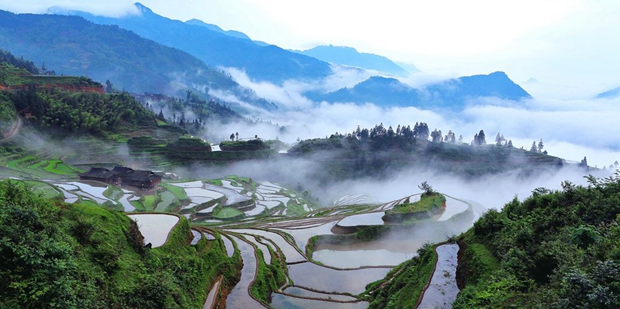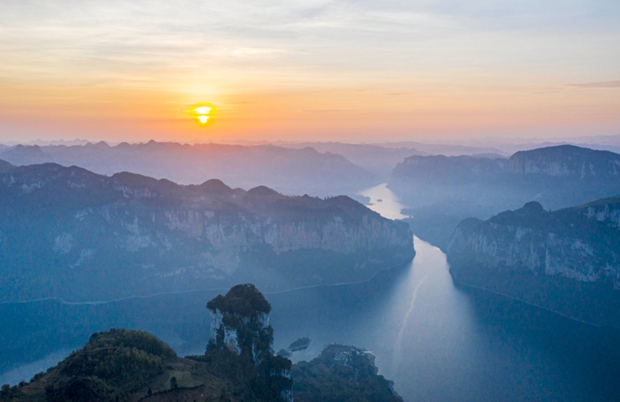Editor's note: According to the concept of sustainable tourism, the development of tourism to improve people's well-being, maintain the ecological environment and increase economic benefits are equally important. Ecotourism is an important branch of sustainable tourism. Its definition not only refers to tourism carried out in the natural environment, but also covers the protection of natural and cultural heritage, the participation and benefit of local residents, the integration and understanding of tourists in the natural and cultural heritage, the construction of facilities and the small impact of tourism activities on the environment. These need the supervision and regulation of the government, the guidance and coordination of social organizations, the self-regulation and implementation of the destination, and the feedback of the market.
Because of its resource endowment, Guizhou has great potential to develop eco-tourism. As a mountainous province, it should be forward-looking to transform into a world-class mountain eco-tourism destination. The unique natural features, biophysical and socio-economic vulnerabilities and resilience of mountain destinations make the path to sustainable development different from other regions. These differences are amplified in the context of climate change. Therefore, it makes sense for the International Mountain Tourism Union to establish ecotourism standards suitable for mountain tourism destinations. The Guizhou-based International Mountain Tourism Alliance plays a leading role as an industry association and has carried out a series of work to promote the sustainable development of mountain tourism.

Guizhou·Jiapang Rice Terraces
Source: International Mountain Tourism Alliance
Starting in 2022, the alliance will organize experts to develop an indicator system for mountain ecotourism. The standards cover all stages of a destination's development, including: organizational management and planning, interaction with the community and nature, facility construction, and operation. The index system is divided into five groups, a total of 94 indicators. The index groups of each stage respectively take into account the principles of sustainable development in three aspects: economy, society and ecology. This set of standards has several features:
Take destination management structure and planning as the basic premise, including land ownership, host community participation, sustainable management strategy, zoning planning control. These basic premises run through the whole process of destination construction, product development and operation. The zoning planning and control method recommends the zoning method of biosphere reserves, namely the tripartite method of core area, buffer area and transition area, or the dichotomy of core protection area and general control area in China, because comparative studies have found that almost all mountain ranges in the world contain biosphere reserves.
The method of "material flow management" is adopted to classify all kinds of substances in the destination boundary according to energy, water and resources, and analyze the quantity and quality of all kinds of substances in and out of the boundary. Unlike other standard systems, which classify resources and pollution, this method treats sewage and waste as neutral substances, which helps to improve the overall efficiency of material use, reduce the impact of man-made construction on the environment, and also lays the foundation for calculating the greenhouse gas emissions (carbon footprint) of the destination. This methodology is fully reflected in the part of destination infrastructure construction.
It involves a number of indicators related to the well-being of residents in the community where the destination is located, and tries to increase quantitative indicators to facilitate measurement. For example, "clarifying land ownership and use rights and their owners", "local residents' satisfaction", "the ratio of the number of tourists to the number of local residents", "tourism employment data for local residents", "the proportion of tourism enterprise profits spent in the local community", as well as reflecting the money remaining in the destination through tourism development, that is, the multiplier effect indicator, and so on.

Guizhou · Wanfenglin
Source: International Mountain Tourism Alliance
Conservation and utilization of biological diversity, natural and cultural heritage, including background investigation of ecological environment and cultural heritage, and conservation and utilization of biological diversity and cultural heritage. Among them, the ecological background survey emphasizes the collection of multi-year continuous data to analyze the impact of climate change. Biodiversity conservation is to avoid animal performances, the introduction of exotic species and so on. On the other hand, the protection of intangible cultural heritage highlights the equality between foreign culture and local culture, focuses on the integration experience of tourists, and abandons the performance display aimed at fast food culture.
Destination operations, including the development of tourism products with the lowest possible impact on the natural environment; Using the polluter pays principle, we can control the negative impact of tourists' behavior on the natural environment through economic means and enhancing tourists' awareness. For example, having information such as a code of conduct for tourists up front and thinking ahead to their departure can not only reduce destination management costs, but also improve the visitor experience. In addition to awareness education for tourists, the indicators also address education and capacity building for local residents and the general public. Because of the different target audience, the content and methods of education and training are different. For the local population, the focus is on regional biodiversity knowledge, climate change adaptation measures, business management, etc., while the education and training of the public is carried out through general education and special research in cooperation with public institutions.

Guizhou · Wujiang Yuan Baili Gallery
Source: International Mountain Tourism Alliance
At present, there are already destinations in China that practice the concept of ecotourism, providing valuable experience for the industry. The Lancang River Park in Sanjiangyuan National Park cooperates with social organizations to provide training in ecological knowledge, guiding skills, financial management and other skills for local Tibetans, and adopts a community collective income distribution system, so that residents can earn economic income regardless of whether they directly participate in the reception. One third of the land area of Libo County is listed as a World Heritage site and nature reserve. At the same time, an open management mechanism of community co-management is adopted, so that local residents can widely participate in the distribution of tourism benefits.
From the formulation and launch of the mountain ecotourism standard to become a standard for regulating the development of the industry, it is based on the concept of ecotourism and the characteristics of the mountain, and also refers to the experience gained by domestic and foreign destinations that practice the concept of ecotourism, but it still needs more extensive multi-party cooperation and more positive actions of local governments.














